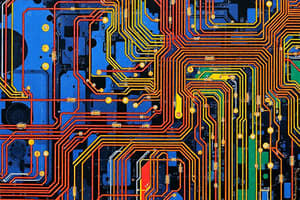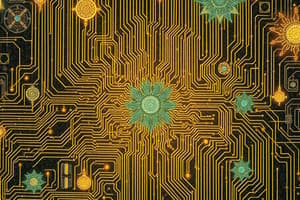Podcast
Questions and Answers
What is the purpose of the characteristic equation in sequential circuits?
What is the purpose of the characteristic equation in sequential circuits?
- Defines the logical properties of a flip-flop in a tabular format.
- Specifies the next state as a function of present state and inputs.
- Enumerates the time sequence of inputs, outputs, and flip-flop states.
- Provides an algebraic representation of the logical properties of a flip-flop. (correct)
Which of the following is NOT a term used to describe a table related to sequential circuits?
Which of the following is NOT a term used to describe a table related to sequential circuits?
- Truth Table (correct)
- Characteristic Table
- Transition Table
- State Table
What is the main function of the flip-flop input equations (excitation equations)?
What is the main function of the flip-flop input equations (excitation equations)?
- To analyze and understand the time sequence of inputs and outputs.
- To represent the logical properties of a flip-flop in an algebraic form.
- To determine the next state of the flip-flop based on the present state.
- To generate the inputs required to control the behavior of the flip-flops. (correct)
How is the 'no change' operation represented in a JK Flip-Flop?
How is the 'no change' operation represented in a JK Flip-Flop?
What does the characteristic equation of a JK flip-flop represent?
What does the characteristic equation of a JK flip-flop represent?
Which statement is TRUE about the 'Set' operation of a JK flip-flop?
Which statement is TRUE about the 'Set' operation of a JK flip-flop?
Which of the following is NOT a common type of flip-flop used in sequential circuits?
Which of the following is NOT a common type of flip-flop used in sequential circuits?
Which statement is TRUE about 'State Equation' in sequential circuits?
Which statement is TRUE about 'State Equation' in sequential circuits?
Flashcards
Characteristic Table (State Table)
Characteristic Table (State Table)
A table that describes the logical behavior of a flip-flop by showing the relationship between inputs, outputs, and internal states.
Characteristic Equation
Characteristic Equation
An algebraic equation that represents the logical behavior of a flip-flop.
Excitation Equation (Flip-Flop Input Equation)
Excitation Equation (Flip-Flop Input Equation)
An algebraic equation that defines how the inputs to a flip-flop influence its next state.
State Equation
State Equation
Signup and view all the flashcards
State Diagram
State Diagram
Signup and view all the flashcards
D Flip-flop
D Flip-flop
Signup and view all the flashcards
JK Flip-flop
JK Flip-flop
Signup and view all the flashcards
JK Flip-flop (Complement Mode)
JK Flip-flop (Complement Mode)
Signup and view all the flashcards
Study Notes
Lecture 08 - Analysis of Sequential Circuits
- Course: ECE09: Digital Electronics 1
- Instructor: Engr. Zoren P. Mabunga, M.Sc.
Terms in Sequential Circuits
- Characteristic Table: Defines the logical properties of a flip-flop through a tabular representation of its operation.
- State Table: Enumerates the time sequence of inputs, outputs, and flip-flop states, sometimes called a transition table.
- Characteristic Equation: An algebraic representation of the logical properties of a flip-flop.
- State Equation: An algebraic representation of a sequential circuit's behavior, specifying the next state based on the current state and inputs.
- State Diagram: A graphical representation summarizing the state table's information.
Flip-Flop Input Equations (Excitation Equations)
- Defines, algebraically, the circuit part generating inputs for flip-flops.
Analysis with D Flip-flops
- Shows a circuit diagram with D flip-flops.
Analysis with JK Flip-flops
- JK Flip-Flop Operation:
- J = 0, K = 0: No change to output.
- J = 0, K = 1: Reset (output to 0).
- J = 1, K = 0: Set (output to 1).
- J = 1, K = 1: Output complements (changes to its opposite state).
- Characteristic Equation: Q(t+1) = JQ' + K'Q
Analysis with T Flip-flops
- T Flip-Flop Operation:
- T = 0: No change to output.
- T = 1: Output complements.
- Characteristic Equation: Q(t+1) = T'Q + TQ'
Studying That Suits You
Use AI to generate personalized quizzes and flashcards to suit your learning preferences.





